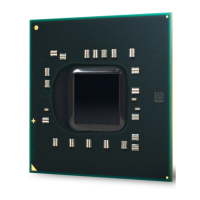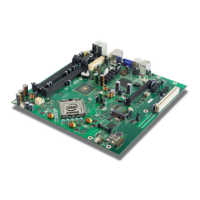Thermal Specifications and Design Considerations
108 Datasheet
5.1 Monitoring Die Temperature
The processor incorporates three methods of monitoring die temperature:
•Thermal Diode
•Intel® Thermal Monitor
• Digital Thermal Sensor
5.1.1 Thermal Diode
Intel’s processors utilize an SMBus thermal sensor to read back the voltage/current
characteristics of a substrate PNP transistor. Since these characteristics are a function
of temperature, these parameters can be used to calculate silicon temperature values.
For older silicon process technologies, it is possible to simplify the voltage/current and
temperature relationships by treating the substrate transistor as though it were a
simple diffusion diode. In this case, the assumption is that the beta of the transistor
does not impact the calculated temperature values. The resultant “diode” model
essentially predicts a quasi linear relationship between the base/emitter voltage
differential of the PNP transistor and the applied temperature (one of the
proportionality constants in this relationship is processor specific, and is known as the
diode ideality factor). Realization of this relationship is accomplished with the SMBus
thermal sensor that is connected to the transistor.
The processor, however, is built on Intel’s advanced 45-nm processor technology. Due
to this new processor technology, it is no longer possible to model the substrate
transistor as a simple diode. To accurately calculate silicon temperature use a full bi-
polar junction transistor-type model. In this model, the voltage/current and
temperature characteristics include an additional process dependant parameter which
is known as the transistor “beta”. System designers should be aware that the current
thermal sensors may not be configured to account for “beta” and should work with their
SMB thermal sensor vendors to ensure they have a part capable of reading the thermal
diode in BJT model.
Offset between the thermal diode-based temperature reading and the Intel Thermal
Monitor reading may be characterized using the Intel Thermal Monitor’s Automatic
mode activation of the thermal control circuit. This temperature offset must be
considered when using the processor thermal diode to implement power management
events. This offset is different than the diode Toffset value programmed into the
processor Model-Specific Register (MSR).
Tabl e 27 and Tab l e 28 provide the diode interface and transistor model specifications.
Table 27. Thermal Diode Interface
Signal Name Pin/Ball Number Signal Description
THERMDA A24 Thermal diode anode
THERMDC A25 Thermal diode cathode

